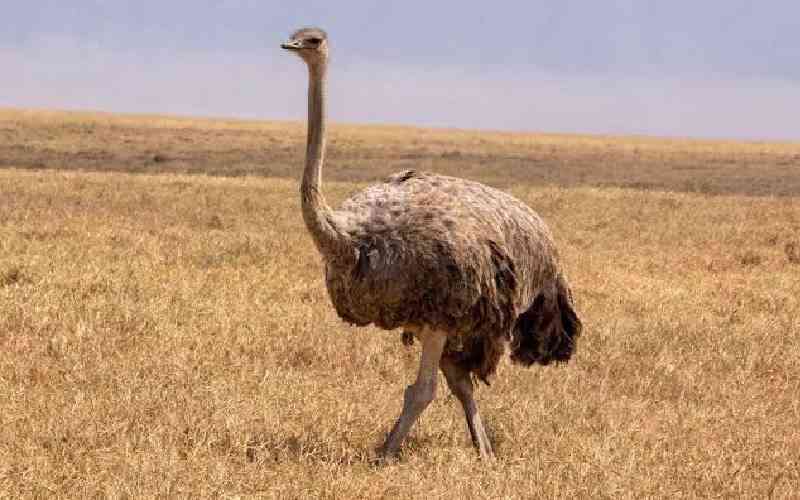
Two green Land Rovers rumble into Konza Technopolis Machakos County, their tyres crunching over clean, well-paved roads lined with working streetlights.
It’s a place of ambition and promise, with well-structured buildings and high-end higher learning institutions rising in the distance and broad avenues cutting through the landscape.
But just beyond the tarmac, the modern city gives way to dry savannah grass, waving lazily in the mid-afternoon breeze.
Inside the vehicles, it’s cramped. Ten people, wildlife veterinarians, vet interns, and capture rangers—are packed in with blue surgical gloves, binoculars, dart gun, and a cocktail of tranquiliser drugs.
This is no tourist drive. Their mission today is both urgent and oddly comical: to treat one of Kenya’s most stubborn patient. Not a lion, not a rhino, but an ostrich.
And not just any ostrich, but a big black-feathered male with a conspicuous pink neck, spotted earlier in the week during a zebra rescue mission.
Rangers had noticed strange lesions on its neck, possibly from a cluster of blood-sucking ticks. Left untreated, the wounds could fester, sap its strength, and shorten its life.
- The Last Laugh: Why Kenya's most detested carnivore deserves better
- KWS embarks on final push to save Northern White Rhinos through IVF
- Between refuge and ruin: How Dadaab's survival battle is fuelling an eco crisis
- Elephants dying from polluted water in the Tsavo
Keep Reading
The Maasai ostrich is the largest living bird species in Kenya and the fastest running biped on earth. An average ostrich weighs around 100 kilogrammes and measures 7-9ft in length, with males growing around two meters tall.
A frightened ostrich can achieve speeds of up to 97 km/h in short bursts, making it the second fastest of all land animals after the cheetah. Their long, powerful legs can cover up to five meters in a single stride, turning them into living locomotives across the African savanna.
The report had reached the Kenya Wildlife Service (KWS) wildlife veterinarians, where Dr Mukami Ruoro Oundo a wildlife veterinarian with nine years of experience was tasked with leading the intervention.
Health threats
Through binoculars, the veterinarians spot them tall shadows moving deliberately across the plain. Several birds are grazing together, the males striking in their jet-black plumage with white feathers, the females in softer greys and browns. But none of these is the patient.
Then the phone rings. On the far side of the ranch, Africa Network for Animal Welfare (ANAW) officers have eyes on the target: the pink-necked male, strutting between two loyal grey-feathered females. He’s unbothered, oblivious to his “most-wanted” status.
When KWS doctors finally see him up close, it’s like a scene from a nature documentary. The big male walks with an easy, confident stride, his powerful legs propelling him forward as if in slow motion. Yet we know those same legs can unleash an 80-kilometre-per-hour sprint — faster than most cars can safely manage in this terrain.
According to the MSD Veterinary Manual, the ticks clustering around this ostrich’s neck represent just one of many health threats these birds face in the wild.
The three types of arthropods commonly affect ratites: lice, ticks, and quill mites. Several species of ticks have been identified on ratite species, with their main importance being as vectors of disease.
Beyond external parasites, ostriches face numerous internal threats including tapeworms and various intestinal parasites. Infectious diseases primarily affect chicks under six months old, with bacterial, fungal, viral, and parasitic agents all posing threats.
The plan is simple in theory: get close enough for Dr Mukami to fire a dart into the thick thigh muscle, where the tranquiliser can work quickly. In practice, it’s like trying to catch smoke with your hands.
The bird keeps just enough distance to stay out of range. Every time the vehicle edges closer, he shifts, disappears into the grass, reappears 200 metres away, still flanked by his companions.
“This is one of the biggest challenges,” Dr Mukami explains. “With ostriches, the only safe place to dart is the thigh. They have to expose it, and they don’t always oblige.”
At 3.25 p.m., after nearly an hour of patient manoeuvring, the perfect moment comes. The bird shifts his stance, and the left thigh is visible. Dr Mukami takes aim through the dart gun’s scope and fires.
The pink-tipped dart hits, a small victory, but there’s a problem. It bounces off too quickly.
“We retrieved it and saw that some drug had gone in, but maybe not enough,” she says. “We gave him 15 minutes, hoping he’d slow down.”
The ostrich does become slightly sluggish, but not sluggish enough. Instead of collapsing, he breaks into a run that turns into a long, looping chase across the savannah.
The Land Rovers follow, careful not to spook him into dangerous sprints.
By now, the sun is inching lower. The wind is becoming harsher. The rules are strict: no darting after a certain time. If the animal runs off under sedation in fading light, tracking becomes dangerous and nearly impossible.
Dr Mukami decides to wait, observing from a distance to ensure the first dose wears off before attempting another shot.
Meanwhile, the bird leads the convoy over uneven ground, past gullies and patches of thick grass that hide sudden ditches.
“It’s not always like this,” explains Lynn Simaloi, a KWS vet intern. “But with ostriches, you can’t predict anything. They’re too fast, too stubborn, and sometimes too clever.”
Throughout the pursuit, the two grey-feathered females stay close to the male. Is it protection? Loyalty? Science?
“That’s just how ostriches live,” Dr Mukami says. “One male can have several females in his group. Earlier we saw another male with seven females. It’s not about protecting him it’s just their social structure.”
Still, their presence complicates the mission. Separating a target from companions is hard enough with animals like rhinos or elephants; with an ostrich, whose every muscle is built for speed, it’s even trickier.
Most large animals, once darted, slow down quickly. But an ostrich’s physiology works against the vet team. They have long, powerful legs, huge lung capacity, and the highest running speed of any two-legged creature on Earth.
By late evening, the decision is made. The pink-necked male has evaded treatment for today. He doesn’t know he’s sick. He doesn’t know he’s just spent hours outwitting a convoy of trained professionals.
 The Standard Group Plc is a multi-media organization with investments in media
platforms spanning newspaper print
operations, television, radio broadcasting, digital and online services. The
Standard Group is recognized as a
leading multi-media house in Kenya with a key influence in matters of national
and international interest.
The Standard Group Plc is a multi-media organization with investments in media
platforms spanning newspaper print
operations, television, radio broadcasting, digital and online services. The
Standard Group is recognized as a
leading multi-media house in Kenya with a key influence in matters of national
and international interest.











